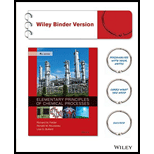
10.10. A ventilation system has been designed for a large laboratory with a volume of 1100 m3. The volumetric flow rate of ventilation air is 700 m3/min at 22°C and 1 atm. (The latter two values may also be taken as the temperature and pressure of the room air.) A reactor in the laboratory is capable of emitting as much as 1.50 mol of sulfur dioxide into the room if a seal ruptures. An SO2mole fraction in the room air greater than 1.0 × 10-6(1 ppm) constitutes a health hazard.
- Suppose the reactor seal ruptures at a time t = 0, and the maximum amount of SO2is emitted and spreads uniformly throughout the room almost instantaneously. Assuming that the air flow is sufficient to make the room air composition spatially uniform, write a differential SO2balance, letting N be the total moles of gas in the room (assume constant) and x(t) the mole fraction of SO2in the laboratory air. Convert the balance into an equation for dx/dt and provide an initial condition. (Assume that all of the SO2emitted is in the room at t = 0.)
- Predict the shape of a plot of x versus t. Explain your reasoning, using the equation of Part (a) in your explanation.
- Separate variables and integrate the balance to obtain an expression for.x(t). Check your solution.
- Convert the expression for x(t) into an expression for the concentration of SO2in the room, Cso2(mol SO2/L). Calculate (i) the concentration of SO2in the room two minutes after the rupture occurs, and (ii) the time required for the SO2concentration to reach the “safe” level.
- Why would it probably not yet be safe to enter the room after the time calculated in Part (d)? (Hint: One of the assumptions made in the problem is probably not a good one.)
Want to see the full answer?
Check out a sample textbook solution
Chapter 10 Solutions
Elementary Principles of Chemical Processes, Binder Ready Version
Additional Engineering Textbook Solutions
Process Dynamics and Control, 4e
Elements of Chemical Reaction Engineering (5th Edition) (Prentice Hall International Series in the Physical and Chemical Engineering Sciences)
Starting Out with Python (4th Edition)
Computer Science: An Overview (12th Edition)
Automotive Technology: Principles, Diagnosis, And Service (6th Edition) (halderman Automotive Series)
Degarmo's Materials And Processes In Manufacturing
 Introduction to Chemical Engineering Thermodynami...Chemical EngineeringISBN:9781259696527Author:J.M. Smith Termodinamica en ingenieria quimica, Hendrick C Van Ness, Michael Abbott, Mark SwihartPublisher:McGraw-Hill Education
Introduction to Chemical Engineering Thermodynami...Chemical EngineeringISBN:9781259696527Author:J.M. Smith Termodinamica en ingenieria quimica, Hendrick C Van Ness, Michael Abbott, Mark SwihartPublisher:McGraw-Hill Education Elementary Principles of Chemical Processes, Bind...Chemical EngineeringISBN:9781118431221Author:Richard M. Felder, Ronald W. Rousseau, Lisa G. BullardPublisher:WILEY
Elementary Principles of Chemical Processes, Bind...Chemical EngineeringISBN:9781118431221Author:Richard M. Felder, Ronald W. Rousseau, Lisa G. BullardPublisher:WILEY Elements of Chemical Reaction Engineering (5th Ed...Chemical EngineeringISBN:9780133887518Author:H. Scott FoglerPublisher:Prentice Hall
Elements of Chemical Reaction Engineering (5th Ed...Chemical EngineeringISBN:9780133887518Author:H. Scott FoglerPublisher:Prentice Hall
 Industrial Plastics: Theory and ApplicationsChemical EngineeringISBN:9781285061238Author:Lokensgard, ErikPublisher:Delmar Cengage Learning
Industrial Plastics: Theory and ApplicationsChemical EngineeringISBN:9781285061238Author:Lokensgard, ErikPublisher:Delmar Cengage Learning Unit Operations of Chemical EngineeringChemical EngineeringISBN:9780072848236Author:Warren McCabe, Julian C. Smith, Peter HarriottPublisher:McGraw-Hill Companies, The
Unit Operations of Chemical EngineeringChemical EngineeringISBN:9780072848236Author:Warren McCabe, Julian C. Smith, Peter HarriottPublisher:McGraw-Hill Companies, The





